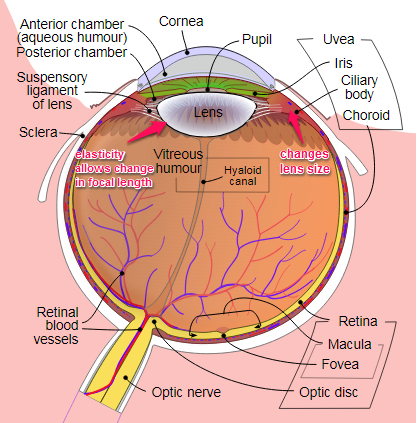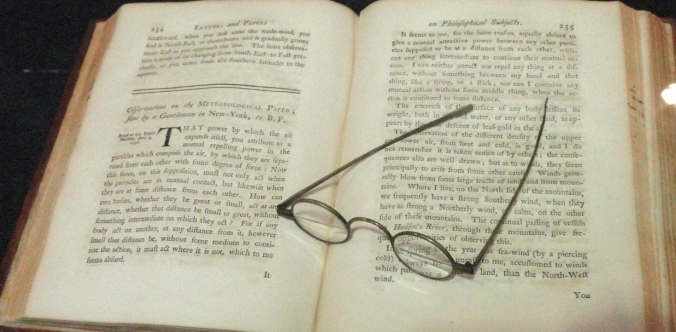 As Always, this was written entirely by Ric Peralta, the Optical Jedi
As Always, this was written entirely by Ric Peralta, the Optical Jedi
First and foremost I apologize for the extended absence I had from the blog. The holiday season, with a 10 year old daughter, a wife who bakes like a madwoman, and all that goes along with this kept me away for a bit. But I’m back and here to edify!
I recently had a friend post on Facebook, complaining about her loss of vision after 40 and it struck me that there are probably many of you out there that don’t really understand why this is happening and why progressive lenses are needed.

So What’s Going On Anyway?
Before we can run, we have to walk. So to start, the basics of what is going on with how we see.

The lens, which sits behind the cornea and pupil, is the part of the eye which allows light to focus on the retina. The lens material itself is elastic and can be reshaped as the muscles (ciliary body) around the eye either contract or relax to change the shape of the lens, and thus the focal length of the light entering the eye. The relaxed state of the lens allows for the best distance vision possible. We need these muscles to change the shape of our lens to allow us to see up close.
As many of us in our 40’s know, there are plenty of parts of the body which lose the ability to bend and stretch smoothly as we age. The eye is no different. As we cross over 40 years old, the elastic nature of our lens starts to decay. The lens becomes more rigid and inflexible (I could make a joke about all of us over 40 getting set in our ways and being inflexible by I’ll demur for the moment).
As this elasticity reduces and the lens becomes more locked into a distance focal length, we lose the ability to see things up close comfortably.
So How Do We Correct It?
If you’re old enough, and you have cataracts, surgery can be a solution. But short of that, the easiest and fastest, simplest solution is to get glasses. Really, the big question then becomes what type of glasses will best solve your issues?
Readers
If you don’t have a distance correction as well, then simple readers can potentially solve your problems. While they give a very wide near vision space to look through, they definitely have their drawbacks.
If you attempt to look into the distance through near-vision glasses you will find the world severely blurred and they can even make you slightly nauseous. If you want to look into the distance, you need to either wear them down your nose and look over the top, or take them off completely. In addition, you need to find a way to carry single vision reading glasses, since they can’t be on your face for all activities. This can lead to losing them easily and severe problems with keeping them adjusted well enough to stay on your face.

Single Vision Reading Glasses
If you have a need to bounce your vision between full near and distance or intermediate (think desktop computer or dashboard in car), readers can also have a severe limitation for you and it might be smarter to consider some sort of multifocal solution.
Lined Bifocals
While this technology is significantly more old fashioned (Ben Franklin invented them after all!) it is a tried and true solution that can give you both clear distance and near vision. The biggest advantage with the lined bifocal is the very wide reading and distance viewing zones. However, there is at least one major trade-off you can’t get arm’s length into view.

Benjamin Franklin’s bifocals
Lined Trifocals
To fill in the intermediate zone, you need to have a third focal length in the glasses. This is where the lined trifocal comes into the conversation. And while it gives you that arm’s length in focus, it still has some other limitations similar to the lined bifocal. With a hard horizontal line separating each focal length, you necessarily have a distinct horizontal blur for anything that is not in the corresponding distance zone. In addition, if anything falls between the focal lengths for these three specific distances, you will have to move your head or body to find the clear image.
Progressive (or No Line Bifocal) Lenses
This solution gives the smoothest top to bottom clarity, focusing at distance, intermediate, near, and everything in between. Of course there is no such thing as a free lunch. Progressives do cost a fair bit more, and the blur lines get moved to the sides so the lower corners of your peripheral vision is where it’s less clear.
To be fair I’ve written MUCH about this lens technology, so I feel it redundant to write too much here. Let’s just say I think this is the best cosmetic and functional solution for the presbyopic patient and have specific lens technology recommendations for prescription and lifestyle scenarios.
Other Solutions
There are some interesting new technologies in development, including eyeglass lenses that are filled with liquid so they can be shifted from one focal length to another with a switch. Since these are not commonly available yet, I won’t go into them at any great length here. As mentioned earlier, cataract surgery can also go a long way to solving the multifocal problem…but this is only a solution for patients who have significantly advanced cataracts which would allow for the surgery.
In Conclusion
While it can be a drag to have to need glasses to see up close, it’s a part of aging and EVERYONE will face it eventually. And let’s face it, it’s better than the alternative to not making it to your 40s, 50s, etc. There are myriad lens technologies out there to make you see comfortably in almost all distances and scenarios. The key is to be honest with your optician and remember there goal is to help you see the best you can. Be straight forward about your visual expectations and let them guide you to best solution for your needs.
P.S.
There are contact lens solutions for presbyopic patients and many have developed far enough that they can be a very good solution for you. I hope to write more on this when digging deeper into contact lenses in an upcoming article.
Greetings Optical Jedi,
I’m in my late 60’s, nearsighted, and in need of rx to see up close. I’ve also become less secure visually when driving at night, so I’m keenly interested in opinions you’ve posted about the Zeiss DriveSafe lens and Varilux X series. As you’ve worn both for a while, which would you recommend as a general use lens for someone willing to buy other glasses for computer/reading/sports? One thing I really want in a general use progressive lens is the ability to see far away and intermediate as clearly as possible across a large portion of the lens (considering it’s a progressive).
Also, does Essilor make a lens comparable to the DriveSafe? If yes, which is it? I ask because there are almost no Zeiss providers in my vision plan network.
Thanks for your wisdom!
LikeLike
Hi there Susan!
Thanks for reading my articles. You are correct in surmising the X design and Zeiss DriveSafe would be the best options if you want to emphasize distance and intermediate. The X is still my current favorite lens, even after trying over 70 designs. It would be an elegant choice for you.
LikeLike
Susan, I apologize for not seeing your message sooner. For general use, I find the Varilux X more versatile. In particular, because the near zone is significantly wider. The Zeiss DriveSafe gives an exceptional width to the midrange (computer/dashboard) zone. If you’re reading add is still relatively mild, this can be great, but being in your late 60’s I would suspect the X Design would be more comfortable for you.
I recently added a new review for the Comfort Max which could also be a good fit for you, depending a bit on your lifestyle needs. Check out that article here: https://opticaljedi.com/2020/09/21/full-review-of-varilux-comfort-max/
LikeLike
Thanks so much for your comments â they are VERY helpful!
Susan Sonkin
###
This email message from EBS is for the sole use of the intended recipient(s) and may contain confidential and privileged information. Any unauthorized review, use, disclosure or distribution is prohibited. If you are not the intended recipient, please contact the sender by reply email and destroy all copies of the original message.
LikeLike
My absolute pleasure! My goal is make sure everyone is wearing the best lenses for their situation
LikeLike
Thank you so much for your fast response!
Am I correct in understanding that, in your experience, the Varilux X design works as well as the Zeiss DriveSafe for driving, and driving at night in particular?
Thanks again!
LikeLike
I do. I would strongly suggest adding Transitions light intelligent lenses to maximize the night vision benefit. Also make sure you use Crizal sapphire anti reflective coating.
LikeLike